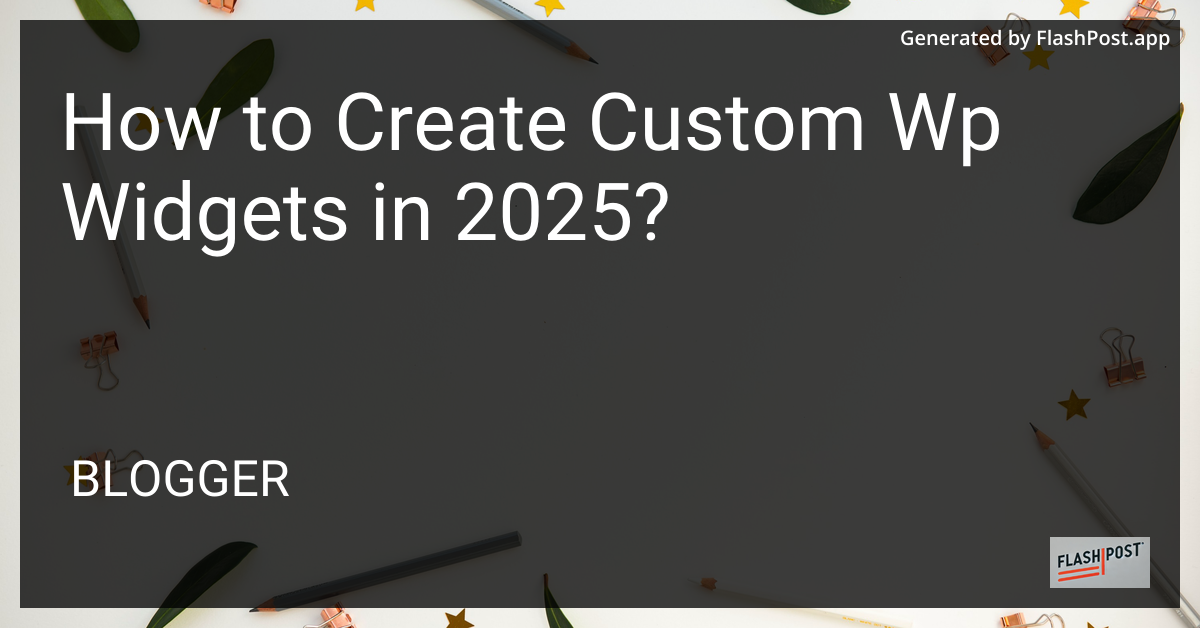How to Create Custom Wp Widgets in 2025?

How to Create Custom WordPress Widgets in 2025
Creating custom WordPress widgets can significantly enhance your site’s functionality and user experience. Whether you’re looking to display custom content, interact with users, or integrate third-party services, building a custom widget is a straightforward way to achieve these goals.
Best Wordpress Books to Buy in 2025
| Product | Features | CTA |
|---|---|---|
 WordPress for Beginners 2025: A Visual Step-by-Step Guide to Mastering WordPress (Webmaster Series) |
Don't miss out ✨

| GenerateAmazonOfferMarkdownDevto|
 Ultimate WordPress Handbook: An Essential Guide to Designing Stunning WordPress Websites, Driving Traffic, and Boosting Revenue (English Edition) |
Don't miss out ✨

| GenerateAmazonOfferMarkdownDevto|
 WordPress For Dummies (For Dummies (Computer/Tech)) |
Check price 💰

| GenerateAmazonOfferMarkdownDevto|
 WordPress To Go: How To Build A WordPress Website On Your Own Domain, From Scratch, Even If You Are A Complete Beginner |
Get It Today

| GenerateAmazonOfferMarkdownDevto|
 WordPress: The Missing Manual: The Book That Should Have Been in the Box |
Shop now 🛍️

| GenerateAmazonOfferMarkdownDevto
Table of Contents
- Understanding WordPress Widgets
- Setting Up Your Development Environment
- Creating a Basic Custom Widget
- Enhancing Your Widget
- Tips and Best Practices
Understanding WordPress Widgets
WordPress widgets are modular components that can be added to your site’s sidebar or other widget-ready areas. They allow you to add content and features without writing custom code for the front-end.
Setting Up Your Development Environment
Before you begin, ensure you have a local or staging WordPress environment to test your custom widget. Tools such as XAMPP or Local by Flywheel can create local development environments. Also, familiarize yourself with the WordPress code references for deeper insights.
Creating a Basic Custom Widget
- Register the Widget
Begin by registering your widget in thefunctions.phpfile of your theme:
function my_custom_widget() {
register_widget( 'WP_My_Custom_Widget' );
}
add_action( 'widgets_init', 'my_custom_widget' );
- Define the Widget Class
Create a new class extendingWP_Widget:
class WP_My_Custom_Widget extends WP_Widget {
function __construct() {
parent::__construct(
'my_custom_widget',
__('My Custom Widget', 'text_domain'),
array('description' => __('A Custom Widget for Displaying Content', 'text_domain'))
);
}
public function widget($args, $instance) {
echo $args['before_widget'];
echo __('Hello, World!', 'text_domain');
echo $args['after_widget'];
}
public function form($instance) {
// Widget admin form
}
public function update($new_instance, $old_instance) {
// Save widget options
}
}
- Display Your Widget
Customize thewidgetmethod to display your content. Use the WordPress functions to interact with your data, potentially even running SQL queries if needed.
Enhancing Your Widget
- Form Method: Use the
formmethod to add fields to the widget settings interface. - Style and Scripts: Enqueue custom CSS and JavaScript using
wp_enqueue_styleandwp_enqueue_script. - Dynamic Content: Implement dynamic PHP logic to enhance user interaction or update content based on context, such as getting current page names.
Tips and Best Practices
- Security First: Always sanitize and validate user input using WordPress security functions.
- Optimize Performance: Minimize database queries and leverage caching when possible.
- Stay Updated: Continuously update your knowledge with WordPress book discounts for the latest insights and tools.
Conclusion
Creating custom WordPress widgets in 2025 requires understanding the core WordPress API and best practices for modern web development. By following these steps, you can effectively create and deploy widgets that enhance your site’s capabilities and offer unique interactive opportunities for your visitors.
Comments
Post a Comment